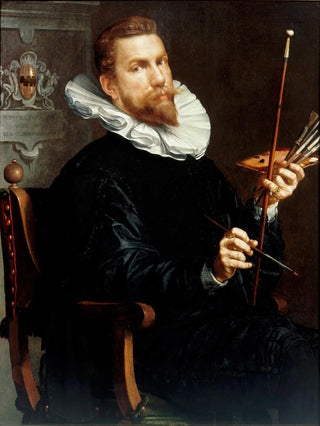Art print | Self-portrait - Joachim Wtewael


View from behind

Frame (optional)
Joachim Wtewael's self-portrait is an iconic artwork that transcends a mere exercise in personal representation. This painting, created in the early 17th century, immerses us in the fascinating world of Dutch painting, where technical virtuosity blends with profound introspection. The artist, by painting himself, does not merely capture his physical appearance; he also offers a glimpse into his soul, his aspirations, and his era. The richness of colors and the finesse of details invite viewers to explore the multiple layers of meaning hidden behind this portrait, making this work a true mirror of the human condition.
Style and uniqueness of the work
Wtewael's self-portrait stands out for its Baroque style, characterized by bold use of colors and a carefully orchestrated composition. The artist excels in the art of light, creating striking contrasts that bring his face to life. The drapery of his clothing, painted with meticulous precision, testifies to his skill in rendering textures and volumes. Every element of the work, from the dark background that accentuates the brightness of the face to the delicate details of the accessories, contributes to an atmosphere that is both intimate and grandiose. This painting is not just a self-portrait; it is an artistic statement where the artist positions himself as master of his destiny, asserting his place in the art world.
The artist and his influence
Joachim Wtewael, born in Utrecht, is a major figure in Dutch painting. His work reflects an era when art and science were in full effervescence, and artists sought to push the boundaries of their creativity. Wtewael, influenced by the Flemish tradition and Italian innovations, develops a unique style that combines realism with a certain idealization. His influence extends well beyond his time, inspiring many contemporary and future artists. Focusing on themes such as identity and representation, he paves the way for a deeper reflection on the role of the artist in society. The self-portrait, in particular, is a work that continues to be a

Matte finish

View from behind

Frame (optional)
Joachim Wtewael's self-portrait is an iconic artwork that transcends a mere exercise in personal representation. This painting, created in the early 17th century, immerses us in the fascinating world of Dutch painting, where technical virtuosity blends with profound introspection. The artist, by painting himself, does not merely capture his physical appearance; he also offers a glimpse into his soul, his aspirations, and his era. The richness of colors and the finesse of details invite viewers to explore the multiple layers of meaning hidden behind this portrait, making this work a true mirror of the human condition.
Style and uniqueness of the work
Wtewael's self-portrait stands out for its Baroque style, characterized by bold use of colors and a carefully orchestrated composition. The artist excels in the art of light, creating striking contrasts that bring his face to life. The drapery of his clothing, painted with meticulous precision, testifies to his skill in rendering textures and volumes. Every element of the work, from the dark background that accentuates the brightness of the face to the delicate details of the accessories, contributes to an atmosphere that is both intimate and grandiose. This painting is not just a self-portrait; it is an artistic statement where the artist positions himself as master of his destiny, asserting his place in the art world.
The artist and his influence
Joachim Wtewael, born in Utrecht, is a major figure in Dutch painting. His work reflects an era when art and science were in full effervescence, and artists sought to push the boundaries of their creativity. Wtewael, influenced by the Flemish tradition and Italian innovations, develops a unique style that combines realism with a certain idealization. His influence extends well beyond his time, inspiring many contemporary and future artists. Focusing on themes such as identity and representation, he paves the way for a deeper reflection on the role of the artist in society. The self-portrait, in particular, is a work that continues to be a






